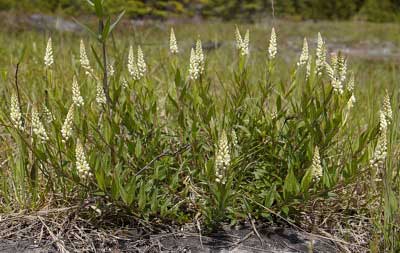Contents:
Common Names | Parts Usually Used | Plant(s) & Culture | Where Found | Medicinal Properties | Biochemical Information
Uses | Formulas or Dosages | Warning | Bibliography
Scientific Names

- Polygala senega L.
- Polygalaceae
- Milkwort family
Common Names
- Milkwort
- Mountain flax
- Seneca snakeroot
Parts Usually Used
Root
Back to Top
Description of Plant(s) and Culture
Senega snakeroot is a perennial plant, 6-18 inches tall; the hard, crooked, snake-like rootstock produces 15 to 20 or more smooth, erect stems which grow from 6-18 inches high. The alternate, lanceolate leaves are sessile or almost so and come to a fairly sharp point. Small, pea-like, white or greenish flowers grow in dense terminal spikes, 5 sepals, 3 petals and the capsules are small, 2 celled and 2 valved; from May to June.
Back to Top
Where Found
Native to the rocky woods and hills of eastern North America, growing as far sough as North Carolina and Arkansas.
Back to Top
Medicinal Properties
Antispasmodic, cathartic, diaphoretic, emetic, expectorant, stimulant
Back to Top
Biochemical Information
Polygalic acid, virginic, pectic, tannic acids, fixed oil, gum, albumen, salts, alumina, silica, magnesia and iron
Back to Top
Uses
Most commonly used as an expectorant in respiratory problems. The Seneca Indians, who introduced it to the white man, chewed the root to make a mash which was applied to snakebites after cutting the bite and sucking out the poison.
Native Americans also used the root tea as an emetic, to induce sweat, to regulate menses, for colds, croup, pleurisy, iritis, blood poisoning, smallpox, rheumatism, heart troubles, convulsions, coughs, and poulticed root for swellings.
Historically, root tea was used similarly but added pneumonia, chronic bronchitis, whooping cough, asthma; thought to relax the respiratory mucous membranes. Research suggests use for pulmonary conditions.
Back to Top
Formulas or Dosages
The rootstock is used dried. Gather in autumn just before the frost.
Infusion: steep 1 tsp. root in 1 cup hot water. Take 1 cup a day, a mouthful at a time.
Tincture: a dose is from 5 to 10 drops.
Back to Top
Warning
Large doses cause vomiting and diarrhea; an overdose is poisonous. Use with medical supervision.
Back to Top
Bibliography
![]() Eastern/Central Medicinal Plants
Eastern/Central Medicinal Plants, by Steven Foster and James A. Duke., Houghton Mifflin Company, 215 Park Avenue South, New York, NY 10000
![]() The Herbalist Almanac
The Herbalist Almanac, by Clarence Meyer, Meyerbooks, publisher, PO Box 427, Glenwood, Illinois 60425, copyright 1988, fifth printing, 1994
![]() American Folk Medicine
American Folk Medicine, by Clarence Meyer, Meyerbooks, publisher, PO Box 427, Glenwood, Illinois 60425, 1973
![]() The Herb Book
The Herb Book, by John Lust, Bantam Books, 666 Fifth Avenue, New York, NY. copyright 1974.
 How Indians Use Wild Plants for Food, Medicine & Crafts
How Indians Use Wild Plants for Food, Medicine & Crafts, by Frances Densmore, Dover Publications, Inc., 180 Varick Street, New York, NY 10014, first printed by the United States Government Printing Office, Washington, in 1928, this Dover edition 1974
![]() Indian Herbalogy of North America
Indian Herbalogy of North America, by Alma R. Hutchens, Shambala Publications, Inc., Horticultural Hall, 300 Massachusetts Avenue, Boston, Massachusetts 02115, 1973
![]() Planetary Herbology
Planetary Herbology, by Michael Tierra, C.A., N.D., O.M.D., Lotus Press, PO Box 325, Twin Lakes. WI 53181., Copyright 1988, published 1992
![]() Webster’s New World Dictionary
Webster’s New World Dictionary, Third College Edition, Victoria Neufeldt, Editor in Chief, New World Dictionaries: A Division of Simon & Schuster, Inc., 15 Columbus Circle, New York, NY 10023
